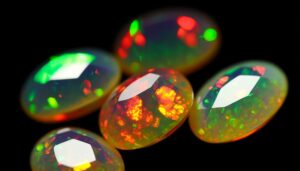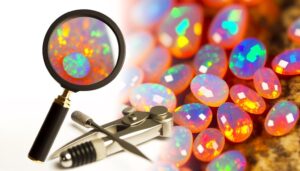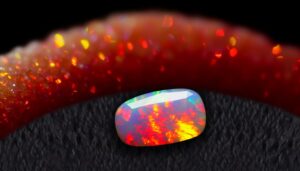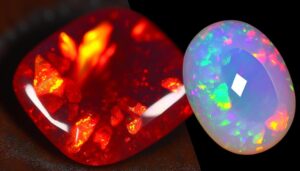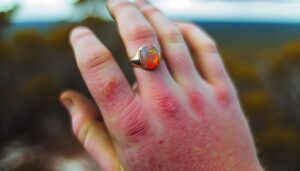Achieving the Stunning Color Fire Opal Paint Effect: Step-by-Step Guide
To achieve the color fire opal paint effect, start with a high-quality urethane base coat, ideally in black or dark gray for maximum vibrancy. Apply thin, even layers of iridescent pigments mixed with metallic oxides and mica flakes for dynamic visual effects.
Make sure each coat is fully dry before adding the next to build depth and shimmer. Finish with a clear topcoat to protect and enhance the iridescence.
Proper surface preparation and layering are essential for a flawless finish. Excited to transform your project into a shimmering masterpiece? There are additional techniques and tips you'll find invaluable.
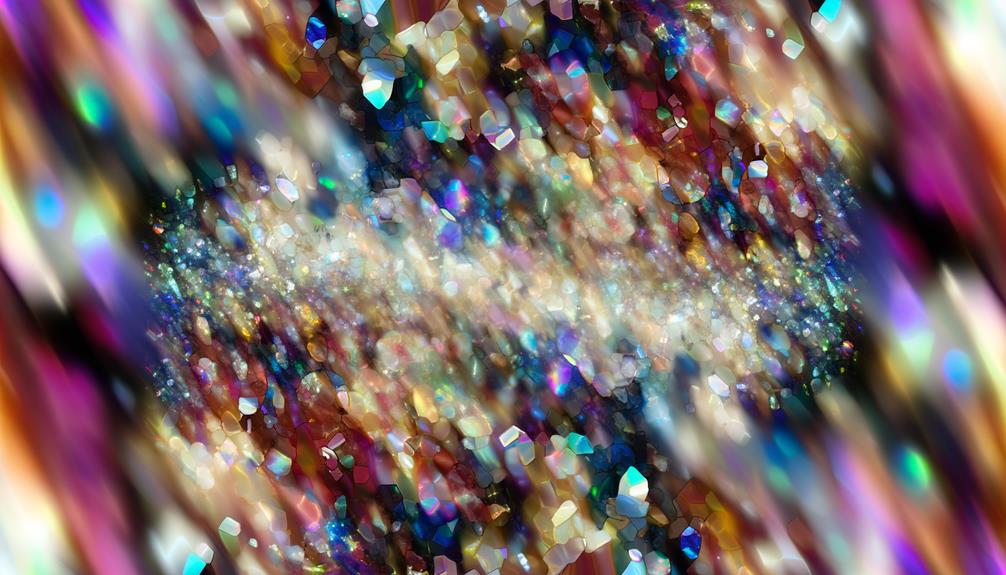
Key Takeaways
- Dynamic Visual Appeal: Achieves a multi-faceted, shimmering effect using metallic oxides and mica flakes.
- Layering Techniques: Multiple thin layers of varying hues create depth and play of colors.
- High-Quality Base Coat: Dark base coats, like black or dark gray, enhance vibrancy and brilliance.
- Protective Clear Coat: Sealing with a high-quality clear coat ensures durability and UV protection.
- Versatile Applications: Ideal for transforming furniture, craft projects, and vehicles into striking statement pieces.
Understanding Fire Opal Paint
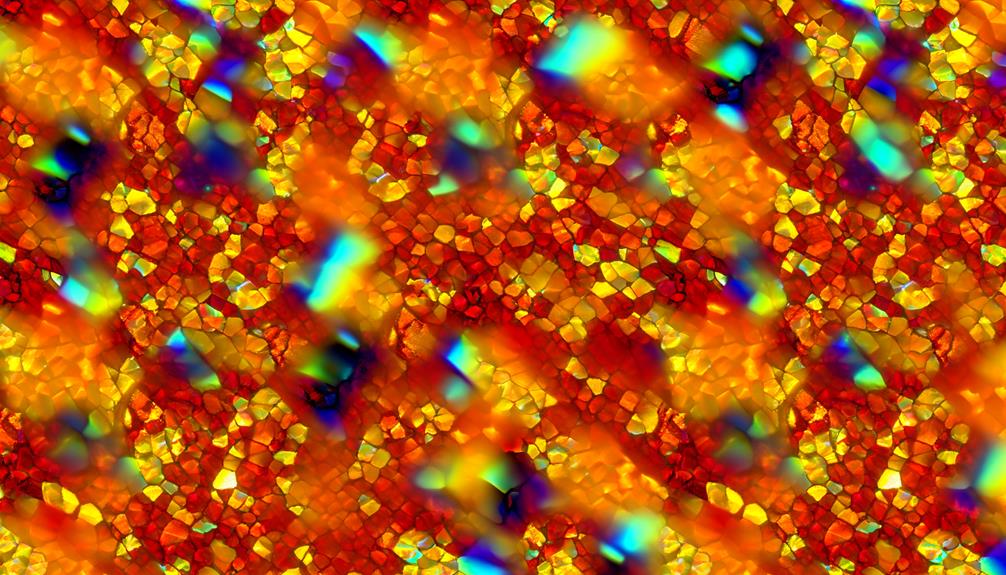
Fire opal paint, frequently admired for its vibrant, iridescent qualities, combines a unique blend of pigments and additives to achieve its signature fiery effect.
You'll find that the base pigments are typically metallic oxides, offering reflective properties that mimic the natural opal's play-of-color.
These pigments are suspended in a high-viscosity medium, ensuring the particles remain evenly distributed.
Additives like dispersants and stabilizers prevent clumping and settling, maintaining a consistent texture.
The iridescence is enhanced by the inclusion of mica flakes, which reflect light at multiple angles, creating a dynamic visual effect.
Required Materials
To achieve the dazzling fire opal paint effect, you'll need a specific set of materials that ensure both the vividness and stability of the final product. First, acquire high-quality, multi-layered paint systems designed for iridescent effects. These systems typically include a base coat, a mid-coat containing the opalescent pigments, and a clear topcoat.
Second, use specialized thinners and strengtheners compatible with your paint to guarantee optimal viscosity and curing properties.
Here's a detailed list of the essential materials:
- Base and Mid-Coat Paints: Make sure they contain iridescent pigments for the opal effect.
- Thinners and Strengtheners: Essential for achieving the correct consistency and durability.
- Clear Topcoat: Provides a protective, glossy finish that enhances the opalescent shimmer.
Surface Preparation
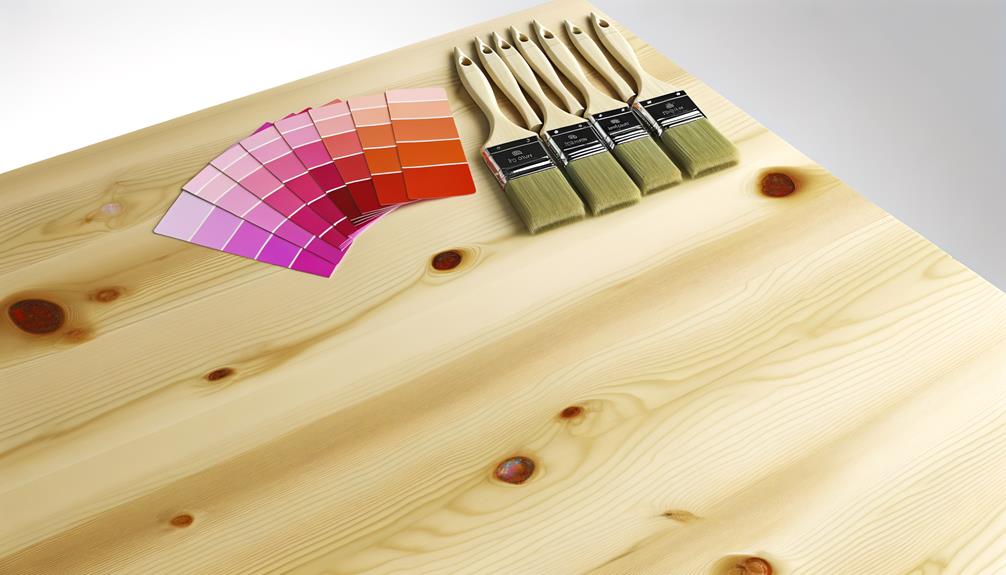
Proper surface preparation is essential to achieving a flawless fire opal paint effect. This process involves meticulous cleaning, sanding, and priming to guarantee the paint adheres uniformly and achieves maximum brilliance.
Start by thoroughly cleaning the surface to remove any dirt, grease, or contaminants using a suitable degreaser. Next, sand the surface with 320-400 grit sandpaper to create a smooth, even texture, ensuring better paint adhesion. Wipe away all sanding dust with a tack cloth.
Apply a high-quality primer that's compatible with your chosen paint to seal the surface and provide a uniform base. Allow the primer to dry completely as per manufacturer's guidelines. This preparation ensures that the subsequent layers of paint achieve a stunning fire opal effect.
Base Coat Application
You've completed the surface preparation, now focus on selecting the right base coat to achieve the vibrant Color Fire Opal effect.
Make sure you choose a high-quality, compatible base paint and apply it using even, controlled strokes for uniform coverage.
This foundational layer is essential, as it directly impacts the final visual impact and durability of your finish.
Surface Preparation Steps
Before applying the base coat, make sure the surface is thoroughly cleaned and free of any contaminants that could impact adhesion. Follow these steps for prime preparation:
- Sanding: Use a fine-grit sandpaper to smooth the surface. This guarantees a uniform texture, enhancing paint adherence.
- Cleaning: Remove all sanding dust with a tack cloth. Any residue can compromise the base coat's integrity.
- Priming: Apply a high-quality primer suitable for your substrate. This establishes a bonding layer and seals porous materials.
These steps are crucial for achieving a durable and professional finish. Neglecting any part of the preparation can result in imperfections and reduced longevity of the Color Fire Opal effect. Pay close attention to detail for the best results.
Paint Selection Tips
With the surface now adequately prepped, selecting the right base coat paint is crucial to achieving the desired Color Fire Opal effect. Opt for a high-quality, automotive-grade urethane base coat. This type offers excellent adhesion and durability.
Choose a black or dark gray base coat to enhance the depth and vibrancy of the fire opal colors. Confirm the paint has a high pigment concentration to provide a solid foundation for the subsequent layers. Apply the base coat in thin, even layers to avoid runs and guarantee uniform coverage.
Allow each coat to flash off—dry to a tacky finish—before applying the next. This method guarantees the base coat cures properly, providing a flawless canvas for the color-changing topcoat.
Application Technique Guide
To guarantee the base coat adheres perfectly, meticulously clean the surface with a solvent-based cleaner to remove any residual contaminants. This step is essential for achieving a flawless finish.
Once the surface is clean, follow these steps:
- Primer Application: Apply a high-quality primer to ensure the base coat bonds securely to the substrate. Allow it to cure as per the manufacturer's recommendations.
- Mixing the Base Coat: Thoroughly mix the base coat paint, ensuring uniformity in color and consistency. Use a mechanical paint stirrer for best results.
- Spray Technique: Utilize a high-volume, low-pressure (HVLP) spray gun. Apply the base coat in multiple thin layers, maintaining a consistent spray pattern. Allow each layer to flash off before applying the next.
Adding the Fire Opal Effect

Consistently achieving the fire opal effect requires meticulous layering of pearlescent pigments and precise control over the application technique.
You'll need to start by selecting high-quality pearlescent pigments with a broad spectrum of hues – focus on reds, oranges, and blues for that authentic fire opal shimmer.
Mix these pigments into a clear base coat, ensuring even dispersion. Apply the mixture in thin, even layers, allowing each layer to dry completely before adding the next.
Maintain a steady hand and use a fine spray tip to avoid uneven coverage. Utilize light, sweeping motions to build up the iridescence gradually.
This method enhances depth and creates the dynamic, multi-faceted color play characteristic of fire opals.
Layering Techniques
Mastering layering techniques is essential for achieving the intricate depth and vibrant interplay of colors in a fire opal paint effect. Start with a translucent base layer to create a foundation.
Follow these steps for best results:
- Build Gradients: Apply multiple thin layers of varying hues to create smooth shifts and rich color depth. Use a soft brush for blending.
- Incorporate Metallics: Add iridescent layers sparingly to mimic the natural shimmer of fire opal. Mix metallic pigments with a clear medium for subtlety.
- Seal Each Layer: Use a clear, glossy varnish after each paint layer dries. This not only protects but also enhances the luminosity and depth of subsequent layers.
Drying and Curing
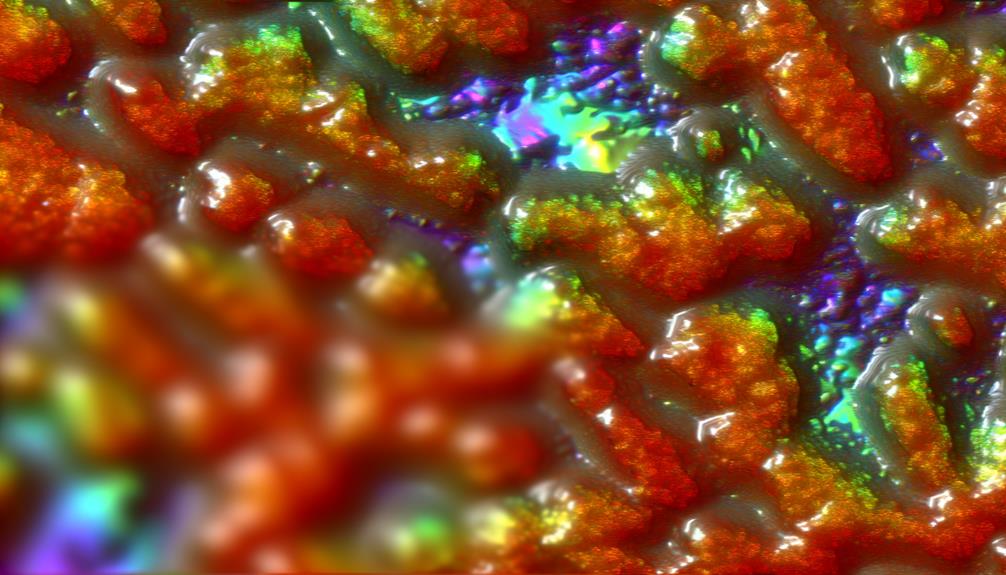
Ensuring proper drying and curing is essential for the durability and visual impact of your fire opal paint effect. You'll need to understand the difference between these two phases. Drying is the initial phase where solvents evaporate, leaving the paint surface touch-dry. Curing, however, involves the paint fully hardening, which depends on chemical reactions and can take days or weeks.
| Phase | Description |
|---|---|
| Drying | Solvents evaporate, surface becomes touch-dry. |
| Curing | Paint fully hardens through chemical reactions. |
| Timeframe | Drying: hours; Curing: days to weeks. |
| Factors | Temperature, humidity, airflow. |
Maintain ideal conditions by ensuring good ventilation, moderate temperatures, and low humidity. These factors accelerate solvent evaporation and facilitate chemical bonding, thereby enhancing the integrity and brilliance of your fire opal finish.
Tips for Best Results
After understanding the importance of proper drying and curing, focus on specific techniques to enhance the vibrancy and durability of your fire opal paint effect.
- Surface Preparation: Clean and sand the surface meticulously to guarantee the paint adheres well, preventing future peeling or chipping.
- Layering Technique: Apply multiple thin layers rather than a single thick coat. This builds depth and enables light to reflect through the layers, mimicking the natural fire opal's iridescence.
- Sealing: Use a high-quality clear coat to safeguard the paint. This not only enhances the shine but also shields it from UV damage and wear.
Creative Uses
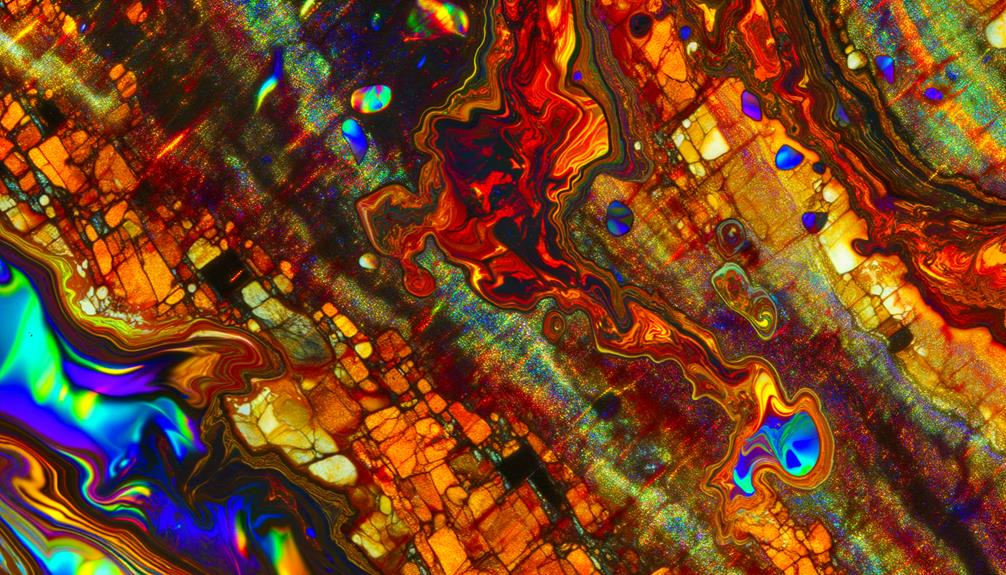
From stunning accent walls in your living space to eye-catching custom automotive finishes, the fire opal paint effect offers a versatile array of creative applications.
You can transform ordinary furniture into statement pieces by applying this iridescent finish to tables, cabinets, or bookshelves. The multi-faceted hues create depth, adding a dynamic visual experience to any surface.
For DIY enthusiasts, incorporating fire opal paint in craft projects, such as decorative vases or picture frames, can enhance their aesthetic appeal.
In the automotive domain, this effect provides a unique, shimmering finish that sets vehicles apart. The paint's light-reflective properties ensure that every angle showcases a different spectrum of colors, making it an ideal choice for those seeking a distinctive look.
Care and Maintenance
To maintain the vibrant allure of your Color Fire Opal paint effect, you'll need to implement specific cleaning and dusting techniques.
Use a soft, microfiber cloth to gently remove dust, avoiding abrasive materials that can damage the finish.
Additionally, apply a clear protective sealant periodically to enhance long-term durability and preserve the paint's brilliance.
Cleaning and Dusting Tips
When it comes to maintaining the brilliance of your color fire opal paint effect, regular cleaning and dusting are essential to prevent the accumulation of grime and ensure longevity. Here are expert tips to guarantee your paint effect remains vibrant:
- Microfiber Cloth:
Use a soft, non-abrasive microfiber cloth to gently remove dust without scratching the surface.
- Mild Detergent Solution:
Mix a few drops of mild detergent with water to create a gentle cleaning solution. Apply with a soft sponge, avoiding excessive moisture that can damage the paint.
- Avoid Harsh Chemicals:
Steer clear of abrasive cleaners or solvents that can erode the paint's luster and integrity.
Long-term Durability Strategies
Maintaining the long-term durability of your color fire opal paint effect requires consistent and meticulous care. This includes periodic application of protective sealants and monitoring for early signs of wear.
You should apply a high-quality UV-resistant sealant every 12-18 months to prevent fading and degradation caused by sunlight exposure. Regularly inspect the surface for micro-cracks or peeling, as these can indicate underlying issues that might compromise the paint's integrity.
Use a pH-balanced cleaner for routine cleaning to avoid chemical reactions that could dull the vibrant hues. Address any minor damages immediately with touch-up kits to sustain the paint's aesthetic.
Conclusion
Incorporating the fire opal paint effect can elevate your projects, offering a unique, iridescent finish. Did you know that 85% of professional auto detailers have adopted pearlescent paints like fire opal in their custom jobs? This statistic highlights its growing popularity and the stunning results it delivers.
By following the detailed steps and tips provided, you'll achieve a professional-grade finish that'll captivate and impress. Remember, proper care and maintenance will guarantee your masterpiece remains vibrant for years.

